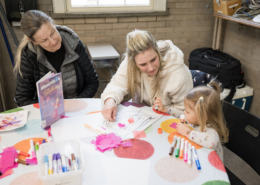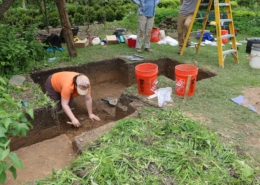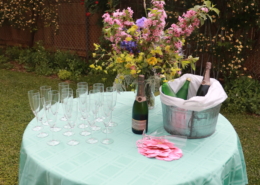Old Roses
 |
| Old Blush Rose |
TUDOR PLACE | OPEN Tuesday – Saturday 10 am – 4 pm; Sunday Noon – 4 pm.
 |
| Old Blush Rose |
Over 178 years of Peter family ownership, Tudor Place’s garden has seen many changes and improvements. In 1969, the last Peter owner, Armistead Peter, 3rd, published his book on the history and evolution of Tudor Place. Included at the end of the book was a formal landscape plan that he had commissioned for that purpose. The plan details the garden’s structure as well as the tree and shrub plantings around the property. This map gives us the clearest view of the family’s intentions and leads our preservation efforts.
As part of our garden restoration project, each missing tree was looked at to determine the feasibility of replanting the same species. For most trees, the same species is still available and were replanted. There were a few trees which required decisions to be made. Most were easy decisions like the American elm we planted last fall. Originally the south lawn was home to three English elms but with the threat of Dutch elm disease and the reality that a red maple and beech tree had been planted in previous years, only one could be restored. We chose to plant a more disease resistant variety of elm, ‘Valley Forge’. Another example would be the three Malus species needed for screening the tool shed on the western side of the south lawn. Originally a tea crabapple and two carmine crabapples stood there. With the difficulty of acquiring those exact species, two newer species were chosen to provide a similar look to the landscape and overall better disease resistance. The hardest decision involves the copper beech trees on the north façade. According to family lore, these trees were bought by Tudor Place’s second owner, Brittania Peter Kennon, from a travelling peddler. Since there is such a variance in what is considered a true copper beech tree, we are not sure what type of tree she purchased. The true variety, ‘Cuprea’, is very difficult to find today and we have not found documentation that this variety was what the peddler was selling. These trees have not been replanted yet.
This week has been busy in the garden and our recent weather has everyone eager for spring. Visitors and staff have remarked on how great the garden looks and have stopped to admire the early flowering bulbs like the crocus coming up in the Thistle Terrace lawn. We have been working hard this winter to get things ready for the upcoming year. Last week, one of our oldest Catalpa trees and a smaller holly (Ilex opaca) on the South Lawn were professionally pruned to take care of some broken limbs damaged in recent storms. Two California Incense Cedar (Calocedrus decurrens) trees by the grape arbor are being removed this month because both trees are diseased and have been officially deemed hazardous. The lean of one tree has become a major concern for visitor safety while its neighbor lost most of its canopy last year during an August storm. We will be replacing both trees in the near future.
Late winter is the time to prune rose bushes. Pruning practices vary depending on rose species and location. We cut back our floribundas and hybrid teas in our knot garden to reduce their size in relation to the boxwood (Buxus sempervirens ‘Suffruticosa’) hedges. The remaining rose species around the property are pruned to remove dead wood and to reshape them like our moss, damask, and china varieties. We also apply lime sulfur spray to our roses to get a jump start on our rose maintenance program.
Strolling the grounds of Tudor Place, across the back driveway and to the garage, if the weather is nice, you will find the garage door open to display a 1919 Pierce Arrow Roadster. This antique car, now decommissioned, belonged to Armistead Peter, 3rd and was one of many Pierce Arrow Roadsters owned by the Peter Family. It is the highlighted object at the upcoming Tudor Nights Coctail Event on September 30 6-8 p.m. (free for members! details: www.tudorplace.org/calendar.html ) So I thought I would share a little of its history to prepare you for the excitement of seeing it up close…
 |
| Photo by Cathy Kerkham |
The Peter family had a long history with the Pierce-Arrow Motor Car Company. Armistead Peter, Jr. and his wife, ‘Nannie’, bought their first Pierce-Arrow in 1913. It was a 48-B2 Vestibule Suburban and cost $6,353.90. Between 1914 and 1920 the Peter family purchased at least four more Pierce-Arrows.
In 1920 they purchased a Town Brougham for a staggering $8,958.00! The Pierce-Arrow currently on display was purchased in 1919 for their son, Armistead Peter 3rd in 1919. It was his second Pierce-Arrow and proved to be his favorite. It is the only Pierce-Arrow he retained from its purchase until his death in 1983. The chassis was bought from the local Washington, DC Pierce dealer, The Foss Hughes Company, for $5,441.25. The body however, was built by the Brewster Company in New York, at a cost of $3,041.45.
Mr. Peter was actively involved in the design process. In the exhibit case are some copies of his designs. He asked Brewster to incorporate a new seat-to-steering wheel ratio designed by Rolls Royce to accommodate his height. The headlights are also by Rolls Royce. There is a box on each side of the running board. One contained the very light Arctic Brand oil that the car used, while the other held tools. A mobile tool kit was essential for an early twentieth century driver. In the 1920s service stations were not commonplace and therefore a driver needed not only to know how to maintain the car but also how to fix it when necessary. This Roadster covered some 37,000 miles, with few problems. Mr. Peter ordered the new Budd-Michelin disc wheels used on General Pershing’s car during World War 1. They were the first to be installed on a civilian car in the Washington area. An earlier skid on an icy winter road had led to a broken wooden spoke wheel, so Mr. Peter was keen to not repeat the performance.
 |
| Armistead Peter, 3rd in the 1919 Pierce-Arrow Roadster Model 48-B5 |
In 1973 Armistead Peter 3rd decided to have the car restored to its original condition. The body and works were restored to running condition and Mr. Peter finally drove it home in 1977. Afterwards he wrote, “When the car was delivered to me in Bethesda, Maryland, I drove it the seven miles to my home here in Washington, and I admit that it felt more like a truck than a car. Everything was built very heavily in those cars, including the gears, and a special trick has to be employed in shifting which I still remembered, although I had not driven the car for forty-seven years.”
Posted by: Heather Bartlow
It seems Armistead Peter Jr. did not empty his pockets before storing away his hunting jacket in the 1930’s! While inventorying the textile collection here at Tudor Place, Collections Assistant Joni Joseph and Intern Rachel Jakab found a whistle, a cup, a leather strap, and a match case in the pockets of that jacket. Joni says – “We think the whistle was to call the dogs while hunting, though I didn’t blow it! We’re not sure what the leather strap was for. The cup is not a collapsible one – it is simply smashed beyond use and as stiff as can be. It is made with a material treated with a waterproof coating.”
As the Education Director of Tudor Place, I work on developing and implementing a number of educational programs and one of my favorite programs, Civil War Washington Teacher Fellowship, takes place over the summer. We partner with Ford’s Theatre, Frederick Douglass National Historic Site, and Lincoln Cottage to create a week long program that focuses on providing teachers with the resources they need to feel comfortable teaching the Civil War to students. This year we had 36 enthusiastic teachers participate in the program. I was overwhelmed with the engaging discussions and creative ideas generated throughout the week.
At Tudor Place we focused on teaching with primary sources. Teachers participated in a Civil War Walking Tour of Georgetown and then performed 3 short plays based on primary documents from the collection. Using additional primary documents teachers took on the role of enslaved workers living in Georgetown in the 1850s and based on their circumstances decided whether they would escape to freedom or stay in bondage. This activity led to a lively discussion on slavery in Washington D.C. and the nation. After working with documents for the majority of the day, teachers turned their attention to teaching with artifacts. Teachers learned the basics of artifact analysis and how artifacts can provide a tactile connection to the past. The day concluded with an engaging discussion on using historic places and artifacts for both history and language arts classes.
Although, teachers spend only a week working onsite with us, we have established an online learning community to encourage discussion and sharing throughout the school year. About 80% of the teachers have already posted lesson plans based on the information they learned throughout the week to the website!
Posted by: Talia Mosconi, Education Director
Fine Arts Conservator Amy F. Byrne of Amy Fernandez, Inc, and Textile Conservator Jennifer Zemanek, examine a tableau made of wax and shells, that once belonged to Martha Washington. The tableau, which depicts the parting of Hector and Andromache, is now part of the collection at Tudor Place Historic House and Garden in Washington, DC.
Below is an article from the Winter/Spring 2010 Tudor Place Times describing the piece in more detail:
A Curious Piece
by Leslie Buhler
Resting atop a sideboard in the Parlour is a curious piece that surprises today’s visitors. It is a rare wax and shell tableau within a glass and wood frame box that was once a prized possession of Martha Washington.
The wax and shell tableau was given to Martha Washington by Samuel Fraunces, an ardent supporter of General Washington. Fraunces owned a tavern in New York City frequented by Washington and his men. It was there on December 4, 1783, that General Washington gave his farewell address to his Revolutionary War officers. (Fraunces Tavern at 54 Pearl Street in lower Manhattan was restored as a Museum and is open to the public.) After he was elected President of the thirteen United States in 1789, President Washington selected Samuel Fraunces to be the household steward of his executive mansion in New York City.
Samuel Fraunces created wax figures, a popular art form during the 18th century. Spectacular displays of life-sized historical figures in elaborate garments were in fashion in both England and the American colonies.
Fraunces chose to create for Mrs. Washington a wax and shell tableau depicting the parting of Hector and Andromache, a popular subject for engravings and paintings during the mid to late 18th century. The waning Age of Enlightenment, the rise of interest in Roman mythology, and a developing Romanticism found expression not only in script but also, in paintings, engravings, and other art forms. Fraunces probably selected his subject because Andromache was honored as the epitome of the loyal wife. An engraving on this same subject was at Mount Vernon and now is held at the Alexandria Masonic Lodge.
Having completed the wax and shell tableau, Fraunces wrote to President Washington: “I most earnestly beg your Excellency will order about the Carriage of a small piece of Shell-Work which I have lately completed for Mrs. Washington purposely – whose acceptance of it will confer the greatest honor on me – the field is Hector and Andromache adorned with Shell-Flowers the collections of a number of years.” New York Governor George Clinton facilitated the shipping of the wax and shell tableau, noting on March 5, 1785 that it was a “. . . very Ginger Bread piece of work.” Upon receipt, it is believed that Martha Washington placed the tableau in the bedroom she shared with her husband.
The wax and shell tableaux was purchased by Thomas and Martha Peter, Martha Washington’s granddaughter, at the 1802 estate sale following Mrs. Washington’s death. The Peters also purchased the chest-on-chest upon which it stood. When the Peter’s home at Tudor Place was completed, the chest-on-chest with the tableau was placed in the upper hallway of the center block. The chest-on-chest remained in this position for six generations of the Peter family. It was a constant reminder of the family’s ties to the Founding Father and his beloved wife.
The winter of 1954/55 the last owner of Tudor Place, Armistead Peter 3rd, was dismayed by the condition of the waxwork. He explained in his book, Tudor Place:
“At some time it had apparently been dropped or treated extremely badly, probably in the moving of the furniture which I have described earlier, at the time of the Civil War. The figures were all thrown about, the nurse on the left side had the right side of her face bashed in, and was lying in the summerhouse. The man had been thrown over and his head snapped off. The woman was still standing but her arm had been pulled loose from the corner of the frame. Most of the flowers had fallen down into the bottom, because it had evidently been put in such heat that the wax had melted that held them together; the animals were in disarray; the whole thing was really a shambles. I decided to do something about this . . . and took it down to the shop, opened it up, took the figures out and laid them carefully on bath towels that I had provided for the purpose, emptied out all the shells that had been parts of the flowers, sorted them all out into similar categories, took out the little summerhouse, and put the whole thing back together in the condition that you now see it.”
Today, however, the wax and shell tableau which so poignantly depicted the sacrifices of the wife of the Founding Father is in a state of severe deterioration. The chest-on-chest on which it so proudly stood is now undergoing a comprehensive conservation effort on Williamsburg, Va.; now this historic tableau also needs major conservation, and funding is sought to repair the ravages of time.
Posted by: Heather Bartlow, Director of Communications
 https://tudorplace.org/wp-content/uploads/2023/12/Ancestral-Spacse_web-scaled.jpg
1707
2560
Comms2018
https://tudorplace.org/wp-content/uploads/2020/01/2020-01-23-300x155.png
Comms20182024-03-28 16:09:492024-03-28 16:11:41Ancestral Spaces: People of African Descent at Tudor Place (Tickets for April 23 – April 28)
https://tudorplace.org/wp-content/uploads/2023/12/Ancestral-Spacse_web-scaled.jpg
1707
2560
Comms2018
https://tudorplace.org/wp-content/uploads/2020/01/2020-01-23-300x155.png
Comms20182024-03-28 16:09:492024-03-28 16:11:41Ancestral Spaces: People of African Descent at Tudor Place (Tickets for April 23 – April 28) https://tudorplace.org/wp-content/uploads/2024/04/Tots-Family-scaled.jpg
1707
2560
Comms2018
https://tudorplace.org/wp-content/uploads/2020/01/2020-01-23-300x155.png
Comms20182024-04-10 11:27:122024-04-10 11:35:07Tudor Tots: What Branches Are on Your Family Tree?
https://tudorplace.org/wp-content/uploads/2024/04/Tots-Family-scaled.jpg
1707
2560
Comms2018
https://tudorplace.org/wp-content/uploads/2020/01/2020-01-23-300x155.png
Comms20182024-04-10 11:27:122024-04-10 11:35:07Tudor Tots: What Branches Are on Your Family Tree? https://tudorplace.org/wp-content/uploads/2024/02/Archaeology-of-a-Possible-Enslaved-Home-Space-at-Tudor-Place-scaled.jpg
1707
2560
Janet Wall
https://tudorplace.org/wp-content/uploads/2020/01/2020-01-23-300x155.png
Janet Wall2024-02-13 16:51:242024-04-01 11:49:56Landmark Lecture: Archaeology of a Possible Enslaved Home Space
https://tudorplace.org/wp-content/uploads/2024/02/Archaeology-of-a-Possible-Enslaved-Home-Space-at-Tudor-Place-scaled.jpg
1707
2560
Janet Wall
https://tudorplace.org/wp-content/uploads/2020/01/2020-01-23-300x155.png
Janet Wall2024-02-13 16:51:242024-04-01 11:49:56Landmark Lecture: Archaeology of a Possible Enslaved Home Space https://tudorplace.org/wp-content/uploads/2024/01/Toast-and-Tour-scaled.jpg
2560
1707
Comms2018
https://tudorplace.org/wp-content/uploads/2020/01/2020-01-23-300x155.png
Comms20182024-01-10 16:13:322024-01-22 12:21:46Champagne Toast & Tour
https://tudorplace.org/wp-content/uploads/2024/01/Toast-and-Tour-scaled.jpg
2560
1707
Comms2018
https://tudorplace.org/wp-content/uploads/2020/01/2020-01-23-300x155.png
Comms20182024-01-10 16:13:322024-01-22 12:21:46Champagne Toast & TourAs an historic site that bears the scars of slavery, Tudor Place seeks to look this injustice in the eye. Click here to learn more.
Advance registration encouraged; suggested donation. Click for info.

1644 31st Street, NW | Washington, DC 20007
202-965-0400 | info@tudorplace.org
Advance registration encouraged; suggested donation. Click for info.

1644 31st Street, NW | Washington, DC 20007
202-965-0400 | info@tudorplace.org
Thank you for your interest in the Through their Eyes resource packet! Please provide your name and email address to download this valuable resource.
[wpforms id=”32425″ title=”false”]

